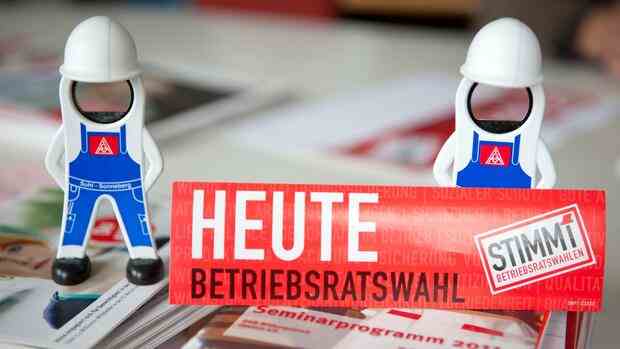Berlin German law gives works councils a lot of power: they help with imminent dismissals or bullying and help determine the organization of working hours, payment principles, the introduction of certain software or personnel policy.
But what is the composition of the works council bodies that were elected this year – 50 years after the reform of the Works Constitution Act? The employer-related Institute of German Economy (IW) examined this in a study. It is available to the Handelsblatt.
The results show that works councils continue to be male-dominated, that employees rely on experienced representatives and that the degree of union membership among members is declining.
In companies with at least five employees, there is the right to set up a works council; is elected every four years. However, workplace representation is becoming less and less widespread.
According to data from the Institute for Economic and Social Sciences (WSI) of the trade union-affiliated Hans Böckler Foundation, only eight percent of all companies in western and eastern Germany had a works council last year. The proportion of employees who are represented by such a body has fallen since 1996 from 51 to 39 percent in the West and from 43 to 34 percent in the East.
Read more about works councils and co-determination
Unlike elections at federal, state or local level, there are no official statistics on works council elections. The IW researchers Christian Kestermann, Hagen Lesch and Oliver Stettes have therefore drawn a non-representative sample from around 750 companies with 240,000 employees who are eligible to vote. The manufacturing industry is clearly overrepresented. With earlier surveys, the results are only comparable to a limited extent due to different samples.
On average, almost 69 percent of the employees in each company took part in the elections – significantly fewer than in the previous election periods. The rate decreases as the size of the company increases: in companies with five to 249 employees it was 75.6 percent, in companies with more than 1000 employees it was only 53.8 percent.
In its own survey, the Confederation of German Trade Unions (DGB) determined a turnout of 72 percent. The elections took place under the impression of the corona pandemic with a lot of short-time work and mobile work, said the second chairwoman of IG Metall, Christiane Benner, to the Handelsblatt. “Given this state of emergency, we are satisfied with the turnout.”
Only every tenth member of the works council is under 30
The experience of their representatives is obviously important to the employees: two out of three elected works council members were already on the committee in the previous period. Around 52 percent are older than 46 years, only around every tenth member is under 30. Works council chairmen are on average 50 years old and have been with the company for 23 years.
In the sample, women make up only 27.6 percent of the elected works councils. In the service sector, where the proportion of female employees is higher than in industry, the figure is 44.8 percent.
At least in the organizational area of IG Metall, however, it was possible to increase the proportion of women in the companies from 23.6 to 24.5 percent, says Benner. He is thus above the proportion of female voters in the represented sectors of almost 21 percent.
Women also make up 16.4 percent of the chairs and 21 percent of the deputies. “Especially in the traditionally male-dominated sectors of IG Metall, the results of the female colleagues show how much the targeted promotion of women pays off,” says Benner.
>> Read the guest commentary by Christiane Benner here: Orderly change instead of static persistence – that’s why we have to reform co-determination
Overall, the situation is different. In the IW sample, only just under 18 percent of the elected works councils are chaired by a woman. In the service sector, with its above-average proportion of women employees, the figure is at least 30 percent.
The trade unions must be concerned that the union density among works council members is tending to fall. According to the IW, it is almost 41 percent overall.
This is relevant because works councils are key players for unions in attracting or retaining members in the company. They also monitor collective bargaining norms fought for by the unions and, if necessary, help to decide on deviations.
In almost every second company, not a single works council member is still unionized. In the last election, this was only the case for 26 percent of the companies. However, the IW researchers concede that the degree of organization could be underreported, since the companies surveyed are probably not always aware of the union membership of the elected works councils.
According to Benner, more than 70 percent of the elected works council members in the metal sector are members of IG Metall. In the organizational area of the industrial union for mining, chemicals and energy (IG BCE), more than three out of four works councils are also members of the union.
According to the IW, the start-up rate for works councils remains at a low level of around 1.4 percent. The Works Council Modernization Act that came into force in 2021, which, among other things, lowered the voting age and increased the scope of the simplified election procedure, has apparently not yet had a major impact.
More: Time clock verdict – Which rules apply to the recording of working hours with immediate effect.

